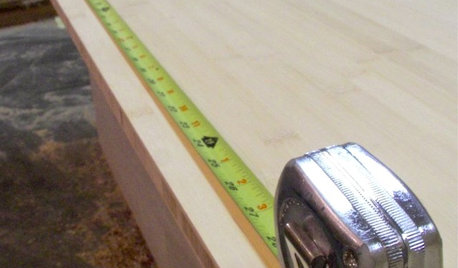Is a scrollsaw the right tool to make this molding? pic
never-give-up
16 years ago
Related Stories

REMODELING GUIDESCrown Molding: Is It Right for Your Home?
See how to find the right trim for the height of your ceilings and style of your room
Full Story
LIFE12 House-Hunting Tips to Help You Make the Right Choice
Stay organized and focused on your quest for a new home, to make the search easier and avoid surprises later
Full Story
CONTEMPORARY HOMESFrank Gehry Helps 'Make It Right' in New Orleans
Hurricane Katrina survivors get a colorful, environmentally friendly duplex, courtesy of a starchitect and a star
Full Story
DECORATING GUIDESArchitectural Details Make All the Difference
Are you missing an opportunity to enhance your home with brackets, cabinet feet and moldings?
Full Story
WOODWORKING7 Must-Have Measuring Tools for Woodworking
Whether you're a newbie DIYer or building cabinets from scratch, using the right woodshop tools makes all the difference
Full Story
KITCHEN DESIGNHouzz Quiz: Which Kitchen Backsplash Material Is Right for You?
With so many options available, see if we can help you narrow down the selection
Full Story
GREAT HOME PROJECTSPower to the People: Outlets Right Where You Want Them
No more crawling and craning. With outlets in furniture, drawers and cabinets, access to power has never been easier
Full Story
BATHROOM DESIGNHow to Choose the Right Bathroom Sink
Learn the differences among eight styles of bathroom sinks, and find the perfect one for your space
Full Story
FIREPLACESThe Right Built-ins for Your Fireplace
Building the perfect storage around your fireplace starts with deciding what it's for. These 14 examples will get you started
Full Story
LANDSCAPE DESIGNHow to Choose a Fence That Feels Right and Works Hard
Making a thoughtful fencing choice now can create happiness for years to come
Full Story









Jon1270
natesgramma
Related Professionals
Hammond Cabinets & Cabinetry · Pearland Carpenters · Roselle Carpenters · Lake Nona Flooring Contractors · Madison Flooring Contractors · Marlborough Flooring Contractors · Palm Harbor Flooring Contractors · Charleston Furniture & Accessories · Chicago Furniture & Accessories · Columbia Furniture & Accessories · Manhattan Furniture & Accessories · Midland Furniture & Accessories · West Palm Beach Furniture & Accessories · Annandale Furniture & Accessories · Sugar Hill Furniture & Accessoriesnever-give-upOriginal Author
Jon1270
natesgramma
never-give-upOriginal Author